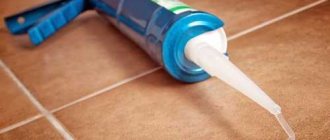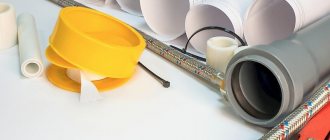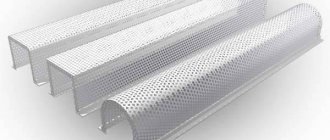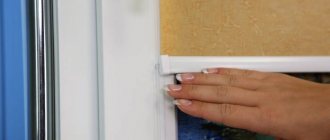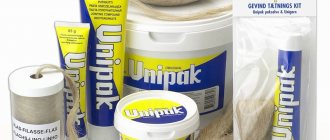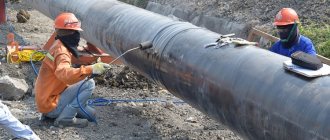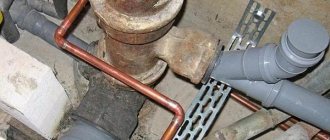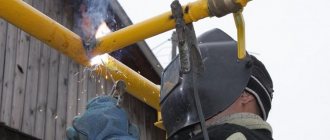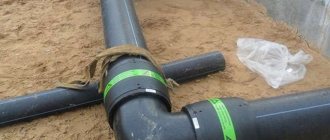Protecting the pipe surface from moisture, chemicals from groundwater, ultraviolet radiation and overheating helps extend the service life of the pipeline to 30 - 50 years. Tape for sealing pipes must be used in all areas where a pipeline branch is laid underground, in the open air, in damp basements. Sewage and water supply systems are protected with waterproofing materials. Pipelines with hot (water, air), hazardous (petroleum products, gas, chemicals) media require additional thermal insulation. Tape insulating materials are used both in the processing of new pipes and on existing pipelines, their sections, to protect joints, bent, uneven surfaces, insertion points of shut-off valves, and element connections.
Waterproofing materials: types and selection criteria ↑
There are ready-made solutions on the market for waterproofing cast iron and steel pipes of any diameter and purpose. The quality and durability of the insulating layer depend on the correct determination of the required type of tape. The choice of insulating material depends on several criteria:
- Manufacturing material.
- Temperatures of the media inside the system.
- Location of installation of the insulated section, exposure of the pipe to high temperature.
- Working pressure, carrier characteristics.
Depending on the initial data, tapes for pipe waterproofing, material for primary surface treatment, and an additional protective film layer are selected.
The tape is suitable for waterproofing difficult areas: bends, areas of expansion/constriction, joints
Heat shrink tapes: scope of application ↑
Double-layer heat-shrinkable tape is available in rolls and is intended for waterproofing pipes and pipeline sections of complex shapes. The winding is performed on a preheated surface. Setting temperature: 80 – 100°C. The installation features require special tools and skills to safely work with heated metal. For this reason, heat shrink tapes for wrapping long pipes are mainly used by professionals.
Bent sections prepared for installation with heat shrink tape
To treat joints, seams, and reinforcement connection areas, special heat-shrinkable sleeves are used. Used for routine repairs of leaky areas.
Heat-shrinkable repair cuffs
The material consists of two inseparable layers - the base and the adhesive composition. The protective outer part is made of polyethylene. The inner adhesive layer of vinyl acetate and ethylene melts easily when heated. The service life of the main line treated with insulation increases by 3 times.
The tape is used for sealing pipes made of heat-resistant materials: copper, steel, cast iron. Not suitable for use on PVC, plastic surfaces.
Tapes based on bitumen and PVC for sealing pipelines ↑
Three-layer insulation roll material consists of a bitumen composition, a base and an anti-adhesive film. Protective polyethylene film protects the material inside the roll from sticking. Asmol mastic firmly adheres to the surface, creating a reliable waterproofing layer. The top layer is a PVC film that protects the bitumen mastic composition from moisture.
PVC based bitumen tape
The main advantage of bitumen tape is the absence of restrictions on use on different materials. Used for waterproofing pipes:
- Made of plastic, PVC.
- Steel, copper.
- Cast iron.
The maximum diameter of insulated pipelines is up to 1.5 m. The minimum service life of treated surfaces is from 35 years. Temperature conditions for work – from 10°C. It is used primarily for sealing underground systems - bitumen does not tolerate overheating well, so its use for outdoor pipelines is limited. The composition of the cold-setting mastic requires pre-treatment of the surface. Before winding it is necessary to apply a primer.
Bitumen tape is used for sealing and insulating underground tanks, cisterns, cable shafts
Couplings and membranes for insulating individual sections of pipes ↑
Difficult sections of pipelines - joints, welded protruding seams, points of connection of narrower and wider pipes - are insulated with heat-shrinkable couplings and cuffs.
The heated surface of the film tightly compresses uneven areas, the molten adhesive composition penetrates into micro-slits and cracks, thereby ensuring complete sealing. The insulation does not lose its properties from exposure to precipitation and ultraviolet radiation. Used to seal and insulate chimney outlets.
Insulating the joint with a heat-shrinkable sleeve
Primers and protective films ↑
Heat shrink tapes are wound directly onto the surface without prior preparation. Self-adhesive bitumen and asmol materials for waterproofing pipes are used only in combination with priming with mastic or primer.
Asmol primers are applied to the cleaned pipe before wrapping it with asmol-bitumen or bitumen-polymer waterproofing film. The primer provides better adhesion of the insulating layer to the base.
Bituminous mastic is used before gluing the tape. Available in ready-to-use form and does not require heating. Mastic can be diluted with solvents.
Pipelines that are exposed to aggressive environmental influences are additionally insulated with polyethylene or PVC wrapping film. A thin layer helps maintain the integrity of the insulation and prevents the appearance of ruptures, cracks, and chips.
Bitumen primer is applied cold
Waterproofing pipes: technology for performing the work ↑
Tape for sealing sewer and water pipes is a material that is easy to apply. It has sufficient elasticity and flexibility for uniform winding. Small diameter pipes can be insulated yourself without using special tools.
Tools you will need:
- Hard metal brushes for cleaning surfaces.
- Synthetic brushes, rollers.
- Trays and containers for primer (mastic).
- If you are repairing a section of a pipeline using heat shrink tape, you should prepare a gas burner to heat the surface.
Pipe free of rust
How is bitumen tape used ↑
Regardless of the type of tape chosen for the work, the material can only be applied to the prepared surface. The pipe must be completely free of scale and rust. In specialized workshops, special machines are used. At home, you can get rid of corrosive deposits with a metal brush or a drill with an attachment.
A layer of primer or mastic is applied to the prepared surface. To facilitate the process, the thick liquid can be diluted with the amount of solvent specified in the instructions.
Important! It is necessary to use a primer or mastic recommended by the waterproofing manufacturer and compatible with the selected tape in terms of chemical composition. Incorrect choice of primer leads to rapid peeling of the winding.
The primer is applied with a wide synthetic brush or roller
A bitumen tape is wound diagonally onto the treated pipe. It is necessary to carry out the winding, constantly monitoring the condition of the fabric: there should be no folds or creases. The edges of the turns are not aligned, but the tape is wound overlapping by several centimeters. Waterproofing a small diameter pipe can be done manually by first installing it on spacers for easy access to the entire surface.
The tape is wound, controlling the degree of tension of the material and the uniform overlap of the edges
It is much more convenient to work with tape if you have a manual machine. A simple mechanical tool will help you insulate a pipe of any diameter in a couple of hours.
The ends of the pipes are left free, waterproofing is carried out after installation and welding. The joints and seams are cleaned and sealed with a cuff or sleeve. The material is heated with a burner to 110°C, the film is heat-shrinkable and compresses the pipe.
Heat-shrinkable coupling at the pipe junction
Leak at the junction: elimination methods
- LiveJournal
- Blogger
Pipes often leak due to poor insulation of joints.
Most often, the user is faced with the fact that a plastic pipe is leaking at the joint. A leak in a metal-plastic pipe can be eliminated by installing new connecting fittings (the line was installed incorrectly), or by replacing the entire wiring (the wrong material was selected - for example, polypropylene was chosen for heating for cold water supply).
Advice: “It is recommended to coat all joints with sealant (for example, a universal heat-resistant sealant for heating pipes can be used).”
A similar defect is observed in cast iron pipelines, but it will be somewhat more difficult to deal with. You can seal a leak in a heating pipe in the following ways.
Caulking joints of cast iron pipes
The joints of such highways can initially be sealed in different ways. Based on this, one or another algorithm of actions is selected.
If the pipes were caulked with lead, to eliminate a leak in the heating pipe you will have to:
- Strip down to the base metal (joint area).
- Caulk the resulting gap, for which it is recommended to use a blunt chisel. The implementation of this repair option is explained by the softness of lead, which easily fills the gap.
It will be more difficult to eliminate a leaking heating pipe that was sealed with cement mortar:
- Remove the remaining cement mixture using a hammer and a narrow chisel.
- Remove the seal and clean the resulting gap.
- Hammer a new sealant (for example, tarred fibers) into the gap, after which it remains to be covered with a cement solution (one to ten).
Advice: “When starting to hammer in new strands, you should take care to pre-treat them with a special mixture, which consists of cement (seven parts), asbestos (three parts) and water (added gradually until the mixture looks like plasticine).”
Pipe joints are sealed with cement
- LiveJournal
- Blogger
Cement is suitable for sealing metal pipes.
There are situations when there is nothing else at hand except cement. It turns out that this is quite enough to seal a leak in a heating pipe.
The sequence of actions is as follows:
- Clean the joint.
- Remove the old seal, for which it is not recommended to use heavy tools, otherwise the pipe may be damaged.
- Prepare cement, water and a wide bandage.
- Dissolve the cement in a small amount of water - a slurry should form, in which the bandage (or piece of gauze) is moistened.
- Wrap the heating pipe with a treated bandage. In this case, each joint is evenly wrapped.
- The structure is left to harden, and after 2…3 hours it is sanded and painted over with suitable paint.
